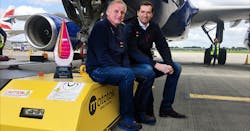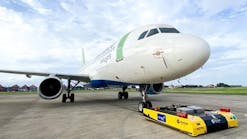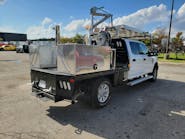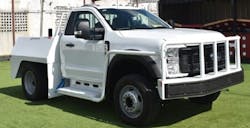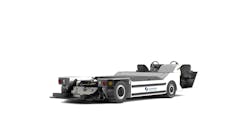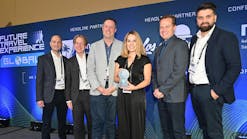After Mototok developed a remote-controlled vehicle that allowed maintenance personnel to tow airplanes, company engineers began working on applying the technology to pushback operations.
As a result, the company launched a vehicle that simplifies the pushback operation with a straight forward interface, and hence doesn’t require an additional license to operate. That, in turn, allows more members of ground handling personnel to perform these duties with the push of a button and drastically reduce delays.
For these reasons as well as many of the Spacer 8600’s other innovative features, Mototok has been named the Ground Support Worldwide 2019 Product Leader of the Year.
A Remote-controlled Evolution
“The basic idea of this machine is 10 years old,” explains Thilo Wiers-Keiser, co-founder and head of sales and marketing at Mototok. “So, the machine is at many MRO and maintenance places to work with narrow-body aircraft already – but as a maintenance machine.”
In 2015, there was an initial test with the unit as a pushback. Then Mototok partnered with ground handlers at Menzies Aviation to trial the units in Copenhagen, Denmark. The Spacer 8600 was tested under winter conditions and performed successfully, completing trials by the end of 2016. Around the same time, British Airways became interested in using the vehicle for pushbacks too, which gave Mototok additional confidence in the concept.
“British Airways actually had one of our Spacer units – they bought one of our units in 2013 for their maintenance in Glasgow, Scotland,” says Paul Acri, sales manager for Mototok America. “So, they were familiar with it on the maintenance side.”
Pushback Requirements
With approximately 150 machines already in the market for maintenance purposes, in addition to units used by aircraft manufacturers in production lines, the vehicle had proven to be reliable.
“It’s a very compact machine in comparison to everything else,” says Wiers-Keiser. “It’s very cost-effective, and it’s very easy to integrate because it needs minimal training requirements. It’s electrical, wireless and has many unique features.”
But when the decision was made to repurpose the machine for pushback operations, some upgrades and adjustments were required. For example, the team at Mototok began by improving the emergency functions to ensure the nose gear could be released quickly in case of a malfunction.
“In the maintenance area, it’s not so stressful and not so urgent. But on a pushback operation, it’s very urgent. So, this was one of the first actions or first things we changed,” Wiers-Keiser points out. “We have two very easy possibilities where it only takes 35 seconds to disengage the nose gear.”
Company engineers also developed a sophisticated over-steering protection system, to make operations safer.
“We measure the torque, but we also do a counter-steer,” Wiers-Keiser says. “If the operator exceeds a certain level of torque, then the machine starts to make a slight counter-steer.
“This avoids any doubt of over-steering. And to continue the pushback process, you don’t have to stop to check everything. In our case, the machine avoids a problem before something can happen.”
He says this feature reduces delays, which results in monetary savings.
“It also warns the operator prior to the event happening to make a counter-steer,” Acri adds.
When torque becomes too high, the operator is notified. But if that person continues, the machine starts the counter-steer.
In this circumstance, an alert is sent to a cloud-based system that notifies managers of the event.
“The computer system allows the owner or fleet manager to check everything that’s going on – with the machine and his team. You can check over-steer issues. You can check charging cycles of each unit,” Wiers-Keiser says. “For example, you can check how many hours the motors are driven to compare maintenance plans. You can really go deeply into each machine and see, as a technician, what is the status of each unit.
“So, if something is not working, you can see online and analyze the situation and quickly repair the machine.”
Managers can use this as a teaching tool if an issue occurs with specific operators or is happening repeatedly.
When maintenance is required, Mototok’s machine cover is designed to allow maintenance staff and technicians easy access to the batteries.
“In general, we have all important electrical and hydraulic parts in one compartment,” Wiers-Keiser says. “You open one big cover, and then you see everything and can exchange – plug-and-play – especially the electronic parts, if necessary.”
Mototok officials say both British Airways and Menzies provided useful feedback during testing that were incorporated into the pushback model.
A Simplistic Process
Capable of handling any narrow-body or regional aircraft, the Spacer 8600 is operated with an intuitive remote-control.
Two joysticks on the device allow an operator to move forward and backward, and left and right. One button raises/lowers the nose gear and another button turns on the lights.
Once the safety check syncs the vehicle to the remote control, the operator is ready to perform a pushback.
The operator drives the Spacer 8600 to the nose gear with the door open. Once engaged with the nose gear according to the tire diameter, the operator closes the door and lifts the nose gear.
“It holds the line very well, and it’s easy to connect. It’s just one button on the remote control to connect to the nose gear. It takes about 20 seconds to connect,” Acri says.
When the pushback is complete, the operator presses the door button again, and the unloading process starts.
“The platform goes down; the wheel will be disengaged as the door is opening. Then he drives out from the nose gear, disengages the pin and the communication set from the aircraft and drives back to the white line; shows the pilot the pin and communication set, then he closes the door, lifts up and goes back to the gate,” Wiers-Keiser says.“That’s the process.”
In addition to simple operation, operators are not burdened with physical tasks that can take a toll on the body. The vehicle moves smoothly as well, thanks to programmed torque.
“The torques are always the same, meaning if I give the command to move forward, it’s going to be a nice, smooth initial torque,” Acri says. “Nose gears and passengers like this. It’s not going to be a jumpy start.”
Plus, there is an additional safety benefit by not being positioned under the aircraft.
“Due to the wireless remote control, they’re standing in a position where the pilot is seeing them and they’re seeing the pilot,” Acri says. “They’re standing a distance away so they can see everything and have better visibility (wing-walker capability), which improves safety. And they never have to go near the engines to disconnect the nose gear.”
Electric Benefits
A key to fully utilizing the all-electric, remote-controlled Spacer 8600 is to have the unit near each gate served, Wiers-Keiser explains.
“The advantage of this is you don’t need time to travel from gate-to-gate, long distances. The machine is always close to one of these gates,” he says, noting a vehicle may efficiently service one to five gates on either side.
Keeping the units close to where they’re used also simplifies charging the vehicles. Mototok’s proprietary charging systems, or an independent charger, can be installed at the gate to charge vehicles when they’re not in use.
“If the machine is parked at that gate, there is normally a charger. If you have a problem with low voltage, you can charge in-between (uses) during the turnaround process,” says Wiers-Keiser.
The batteries can perform up 50 pushbacks with no engines on; and at least 30 if the engines are started during pushback before requiring a charge.
Training Requirements
Another benefit of the Spacer 8600 is the person who operates the unit does not have to be a dedicated pushback driver. Any member of the turnaround team, who has received training, can perform the pushback.
“With our concept, the machine is available always, and not stuck at another gate far away, and you have all these people who are trained, then you can really reduce delays,” Wiers-Keiser says, noting at London Heathrow’s Terminal 5, British Airways reduced its pushback-related delays by more than 70 percent by training many of its workers to use the Spacer 8600.
According to Wiers-Keiser, the airline has 25 Spacer 8600s at their gates at Terminal 5. They trained 150 people to use the units and would like to increase that number to closer to 200 in order to make operations more versatile.
“The operators do not need a special license like you would with other GSE tugs. They also don’t have to get physical,” Acri notes. “So, they don’t need to bend over, squat, wrap something, put an adapter in, strap onto a nose gear or any of those types of things. So, you’re able to have a wide variety of operators."
If a ground handler already has pushback experience, training takes as little as two hours.
“They learn to work the three switches on the remote control, and how much voltage the machine needs to operate and how to change the small battery for the remote control. That’s basically the requirement,” Wiers-Keiser says.
“If a group has no pushback experience, then the training on the machine is the same – but they have to learn all the regulations, how to communicate with the pilot, (etc.),” he continues. “It’s something which everybody who performs pushback has to learn, independent of the machinery.”
More to Come
All the notable features of the Spacer 8600 – from the cloud-based computer system to the remote control – are designed to take complexity away from the operator and maintenance provider.
“If the machine is not complex to learn and to operate, then you avoid mistakes and it increases, in the end, safety,” Wiers-Keiser says, adding an advantage of an electric vehicle is fewer parts that can wear out and need replacing.
With intuitive operation, a 20-plus year life span and the versatility to handle aircraft from CRJs and Embraers up to the Airbus 321, the Spacer 8600 has become an efficient option for many airlines.
The Spacer 8600s in operation at Terminal 5 at London Heathrow have helped perform more than 80,000 pushback operations there. Meanwhile, there are a lot of other airports where the units are in use, for example, in France, China, the United Arab Emirates, Singapore and the United States.
Acri says Allegiant Air became the first airline in the U.S. to utilize the technology, putting units in service at McCarron International Airport in Las Vegas.
“The Spacer 8600 is now dedicated for only narrow-body and regional jets,” Wiers-Keiser says. “There will be development for a stronger machine which can handle then wide-body.”
